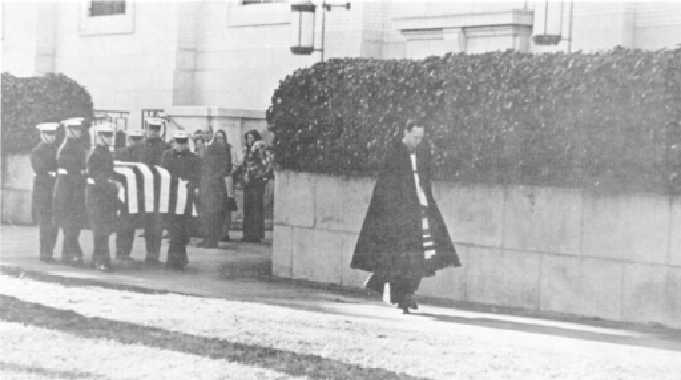287.8(M1)
Figure 4-7.— Departing St. Andrew’s Chapel, U.S. Naval Academy at the conclusion of the chapel
service.
the band renders honors. if a full honor
ceremony is being accorded, followed by a
hymn. At the first note of the hymn, the casket
is removed from the conveyance by the body
bearers and carried into the chapel. As soon as
the casket enters the chapel, the band ceases to
play. The escort is then brought to order and
given “At Ease.”
When honorary pallbearers are present, they
are formed in two ranks, facing each other, thus
forming an aisle from the conveyance to the
entrance to the chapel. At the first note of the
music, and while the casket is being carried
between them, the honorary pallbearers uncover
or salute as appropriate. They follow the casket
in a column of twos into the chapel and sit in
the front pews on the left.
The funeral director, or designated person,
moves the bier (figure 4-6) as previously
prescribed by the officer in charge. If there is no
bier, the body bearers carry the casket as
instructed beforehand.
At the conclusion of the chapel service, the
body bearers follow the honorary pallbearers. If
there are no honorary pallbearers, the body
bearers follow the chaplain in a column of twos
as the casket is moved to the entrance of the
chapel. When honorary pallbearers are present,
they form an aisle from the entrance of the
chapel to the conveyance (caisson or hearse)
and uncover or salute as prescribed.
When the casket appears at the entrance of
the chapel (figure 4-7) at the conclusion of the
service, the funeral escort and band repeat the
procedures prescribed for entering the chapel.
The band ceases playing and the escort is
brought to order when the casket has been
secured to the caisson or placed in the hearse.
After the casket has been placed on the
caisson or in the hearse, the honorary
pallbearers enter their cars. If they are
marching, they form a column on each side of
the caisson or hearse with the leading member of each
4-9

